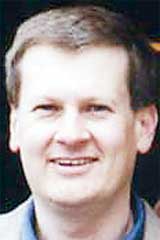The Chart celebrates another milestone

Dr. Chad Stebbins – Director of the Institute of International Studies
After 65 years, The Chart continues to publish.
On Nov. 10, The Chart celebrated its founding. The first issue of The Chart ran on Nov. 10, 1939. Then, the paper cost three cents and advertising revenues only went to publishing costs.
The Chart was founded by Kenneth McCaleb, the first editor.
When the paper began on the campus of Joplin Junior College, it was located in the Guest House behind the Mansion.
Richard Massa, Chart adviser from 1972-84 and former communication department head, was the first adviser to move The Chart from the Guest House.
“The people I worked with, the students, did a tremendous job of working with me,” Massa said.
Massa said conditions for working on the paper were less than desirable.
“We had to send it to a typesetter,” he said. “The typewriters were so archaic to work with. We looked like anything but a professional paper.”
He said that despite the obstacles of working with outdated and poor equipment, the staffs he worked with continued to do their job.
“All the time, the students were doing their best to be professional,” he said. “We were part of the media and part of the press.”
Massa said the most important part of a college newspaper is the strive to continue its work as part of the professional scene.
Steve Smith, news bureau manager, was editor-in-chief during the 1975-76 academic year.
“The workload was pretty heavy,” he said.
Smith worked on several issues not seen in The Chart before. For example, one issue concerned the rights of ex-convicts who try to integrate themselves back into society.
Massa said Smith and others during the time period tried to keep the history of the paper in mind as they wrote about issues important to the time.
Smith said the political tension of the time inspired him to work on his stories and develop them to a degree that was worthy of the time.
“They broke the bounds of what had been put in The Chart before,” Massa said.
Smith said his work on the paper helped him learn things to remember during his career after college.
“One thing that it showed me is how bad of a writer I was,” he said. “It was elephantine. I overwrote, and I don’t think I do that anymore.”
Dr. Chad Stebbins, director of the Institute of International Studies and current Chart adviser, was a former staff member of the paper.
“As a student, it was probably my greatest education,” Stebbins said.
At the time, Stebbins was a marketing and management major because the department of communication did not exist until 1980. The paper was previously under the English department.
In 1983, Stebbins was an assistant adviser after graduating from Southern.
During his work of advising the paper, Stebbins worked on his master’s degree and doctorate.
He became adviser in 1984.
“The challenge as adviser is to remember the history of The Chart, but also take it in a new direction,” he said.
During his time as adviser, The Chart added state coverage and city coverage.
When the international mission was initiated at Southern, the paper added international coverage, including trips abroad.
The first Chart international trip was in 1997.
Lee Pound, alumni director, worked on The Chart for one semester in 1983.
She said the office was small and the equipment was not as fast as today’s standards.
Pound worked under Massa.
“I learned from him that everything has to be right,” she said.
Pound’s mother, Helen Louise Hough, worked on the paper as well from 1948-49. She was an editor in 1949.
Pound said the current communication students and future students should be proud of The Chart.
Stebbins said he hopes The Chart and the other members of the communication department will continue with their roots and also, in the future, work toward convergence in the media fields.
Massa and Stebbins also agreed on the goals for all Chart members.
“Do the very best,” Massa said. “You must make people know you are a member of The Chart. Remain conscious of accuracy and ethics. The basic principles must remain.”
Your donation will support the student journalists of Missouri Southern State University. Your contribution will allow us to purchase equipment and cover our annual website hosting costs.















